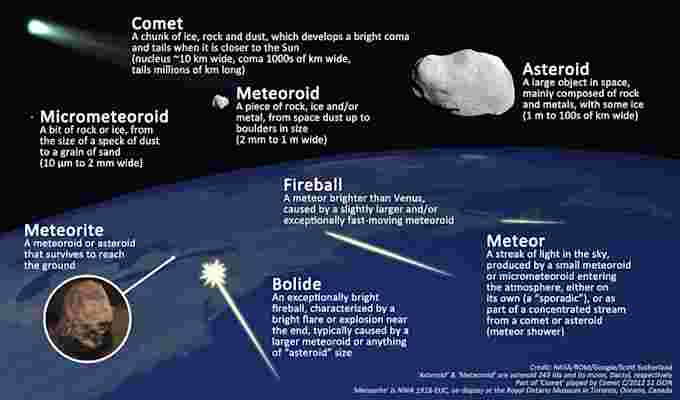Science
Two bright fireballs flashed over the Prairies, almost exactly one night apart – The Weather Network

They came from completely different parts of the sky. Still, one night apart — nearly down to the minute — two bright meteor fireballs flashed over the Prairie provinces this week.
At 9:48 p.m. Central Time, on the night of Tuesday, March 22, witnessed spied a very bright meteor streaking across the sky.
According to the American Meteor Society, the fireball began around 40 kilometres north of Erwood, SK, just east of Highway 9 in the eastern part of the province. Then, for about 5 seconds, it blazed towards the southwest before winking out at a point just west of Fosston, SK, nearly 200 kilometres away.
This map from the American Meteor Society plots the track of the March 22, 2022 fireball over southeastern Saskatchewan (blue arrow). The coloured splotches indicate the “heat map” of observers, with darker colours representing a higher concentration of witnesses who reported the event. Credit: AMS
Based on witness reports, the event was seen as far away as North Dakota, southern Manitoba, and northern Saskatchewan. Even someone from the village of Empress, on the border between Saskatchewan and Alberta, spotted it.
Storm spotter Nick Schenher captured the fireball on his front door camera from Regina, SK.
Space fireball soars over #yqr earlier this evening at 8:48:58pm. #skstorm #meteor #Meteorites https://t.co/gOeaT4TomH pic.twitter.com/GfhQq5C01I
Space fireball soars over Nick Schenher on Twitter: “Space fireball soars over #yqr earlier this evening at 8:48:58pm. #skstorm #meteor #Meteorites https://t.co/gOeaT4TomH pic.twitter.com/GfhQq5C01I / Twitter” earlier this evening at 8:48:58pm. Nick Schenher on Twitter: “Space fireball soars over #yqr earlier this evening at 8:48:58pm. #skstorm #meteor #Meteorites https://t.co/gOeaT4TomH pic.twitter.com/GfhQq5C01I / Twitter” Nick Schenher on Twitter: “Space fireball soars over #yqr earlier this evening at 8:48:58pm. #skstorm #meteor #Meteorites https://t.co/gOeaT4TomH pic.twitter.com/GfhQq5C01I / Twitter” Nick Schenher on Twitter: “Space fireball soars over #yqr earlier this evening at 8:48:58pm. #skstorm #meteor #Meteorites https://t.co/gOeaT4TomH pic.twitter.com/GfhQq5C01I / Twitter” Nick Schenher on Twitter: “Space fireball soars over #yqr earlier this evening at 8:48:58pm. #skstorm #meteor #Meteorites https://t.co/gOeaT4TomH pic.twitter.com/GfhQq5C01I / Twitter” Nick Schenher on Twitter: “Space fireball soars over #yqr earlier this evening at 8:48:58pm. #skstorm #meteor #Meteorites https://t.co/gOeaT4TomH pic.twitter.com/GfhQq5C01I / Twitter”
— Nick Schenher (@NickTheBody) Nick Schenher on Twitter: “Space fireball soars over #yqr earlier this evening at 8:48:58pm. #skstorm #meteor #Meteorites https://t.co/gOeaT4TomH pic.twitter.com/GfhQq5C01I / Twitter”
If that wasn’t amazing enough, the very next night, on Wednesday, March 23, at nearly the same exact time — 9:47 p.m. CT — a second meteor fireball was spotted.
Unlike the one from the previous night, this meteoroid appeared to plunge almost directly downward from space. Based on this, it was entirely unrelated to Tuesday night’s fireball, as the two originated from different points in space.
Alix and Jason Cruickshank caught this one on video from their home in Winnipeg, MB.
Was just looking north in Transcona and saw a shooting star! ☄️ pic.twitter.com/jCmUoQKWRB
Was just looking north in Transcona and saw a shooting star! ☄️ Jason Cruickshank on Twitter: “Was just looking north in Transcona and saw a shooting star! ☄️ pic.twitter.com/jCmUoQKWRB / Twitter”
— Jason Cruickshank (@cdnjay) Jason Cruickshank on Twitter: “Was just looking north in Transcona and saw a shooting star! ☄️ pic.twitter.com/jCmUoQKWRB / Twitter”
Fireballs like this are caused when pieces of rock or ice (meteoroids) plunge into Earth’s atmosphere from space, travelling at speeds of up to hundreds of thousands of kilometres per hour. As it ploughs through the upper atmosphere, a meteoroid compresses the air in its path, which heats the air up so much that it glows. This results in the meteor flash we see in the sky. Given that they occur at altitudes of 50 to 80 km above the ground, a particularly bright flash is typically visible for hundreds of kilometres around.
The meteor flash ends either when the meteoroid is completely vaporized by the heat or when the meteoroid slows enough that it can no longer compress the air to the point of incandescence.
WHAT ARE THE ODDS?
Seeing Tuesday night’s meteor fireball was rare enough.
“A fireball this big and bright is exceptionally rare for a person to see,” Scott Young, the planetarium astronomer at the Manitoba Museum, told CBC Manitoba on Wednesday.
“If you’re a devoted sky watcher and you spend your whole life, you might be lucky to see two. But I mean, it really is a once-in-a-lifetime event.”
Witnessing two fireballs from the same location, on two nights in a row… that has to be exceptionally rare. Right?
Based on the American Meteor Society reports, only one person of the 45 witnesses who saw the Tuesday night fireball — Trevor Bryant, from Brandon, MB — also managed to spot evidence of the Wednesday night event.
Bryant’s webcam captured a great view of the first fireball (embedded below). However, it only managed to record an extremely brief flash of light from the second, as the meteor occurred outside the camera’s point of view.
Watch below: See the March 22 Saskatchewan fireball, as seen from Brandon, MB (at 0:23 of the video)
Witnessing a fireball isn’t just a matter of being outside and looking up.
Fireballs occur randomly, so they can happen at any time (but more on that below). First, it needs to be dark enough to see it, or the fireball has to be bright enough to spot in the light of day. Second, your timing of exactly where you are looking needs to be spot on. These events are here and gone in just a matter of seconds. So, even looking down at your cellphone, turning your head to talk to someone, or moving so a building or trees suddenly block your view of that exact part of the sky could cause you to miss it. Third, you actually need to be able to see the open sky. Clouds in the area could cause even a super-bright fireball to go unnoticed.
So, seeing two meteors like this, almost exactly one night apart, is remarkable.
However, according to Denis Vida, a meteor physics postdoctoral researcher at Western University, the timing of these two may not be all that rare after all.
In an email to The Weather Network, Vida pointed to research written back in 1982 by Canadian meteor astronomers Ian Halliday and Arthur Griffin.
In their paper, Halliday and Griffin gathered what we knew at the time about where meteorites come from — the typical orbits that meteoroids follow around the Sun before they hit Earth. They then used that information to determine when we are most likely to see these meteorite falls, based on the season, the time of day, and our latitude.
Summing up the results, Vida said that “we’ll observe the greatest number of falls during the spring, between sundown and 12 a.m.”
Given that we are just days after the spring equinox, Vida added, we are right at the peak of yearly meteorite fall activity. Plus, when these two fireballs were seen, right around 9:47 p.m. local time, is also right around the peak time of day for this latitude on Earth.
Related: Got your hands on a space rock? Here’s how to know for sure
COULD THERE BE METEORITES?
The typical meteor flash in the sky is caused by a micrometeoroid — probably about the size of a grain of sand — which tends to completely vapourize when it hits the atmosphere. Bright fireballs like these two, on the other hand, are produced by larger objects. The larger a meteoroid is, and the slower it travels through the atmosphere, the greater the chance that part of it could survive to reach the ground.
That’s when there’s a possibility of finding meteorites.


According to Vida, simply based on how long the two fireballs last, it’s possible that perhaps around 100 grams of meteorites may have hit the ground from each. However, more analysis would be necessary to know for sure.
Finding meteorites in Canada is often quite difficult, though. Snow on the ground can make this easier. The scorched black exterior typical of meteorites stands out quite well against the white surface. However, in areas with plenty of trees and underbrush, locating them can be a challenge.
Related: Want to find a meteorite? Expert Geoff Notkin tells us how!
If you think you may have found one, here’s what to look for:
- Look for the black exterior, the “fusion crust” that develops due to the heat from its passage through the atmosphere
- See if it is magnetic. Even an ordinary fridge magnet will tend to stick to a meteorite
- Beware of ‘meteor-wrongs’ such as industrial slag, which can have some characteristics of meteorites but are definitely from here on Earth.
Did you see either of these bright fireballs? If so, report what you witnessed to either the American Meteor Society or the International Meteor Organization. Every eyewitness report helps refine the path of these meteors, improve the science of meteors and fireballs, and potentially even help locate meteorites for study.
Science
Local astronomer urges the public to look up – Windsor News Today – windsornewstoday.ca


If last week’s solar eclipse piqued your interest in astronomy, the Royal Astronomical Society of Canada’s Windsor Chapter plans to show off some of the more dramatic photos and videos members took of the event.
They were stationed along the path of totality along the northern shore of Lake Erie and in the U.S.
“People did take some nice photos with their cellphones, but we have members who took photos and videos with their telescopes,” said member Tom Sobocan. “You’ll see some pretty impressive shots.”
About 100 members are in the local chapter, which meets every third Tuesday of every month.
Thursday’s meeting is at the Ojibway Nature Centre on Matchette Road. It starts at 7:30, and it’s open to the public. Seating is limited, so Sobocan recommends arriving early.
Astronomers are looking ahead to new wonders in the heavens. Right now, the Pons-Brooks Comet, another once-in-a-lifetime opportunity, is approaching Jupiter in the constellation of Aries.
“If you’re in a dark-sky location, you can see it with the naked eye, and from inside the city, you can see it with binoculars,” said Sobocan. “It may get a little bit brighter going towards the fall, but our members have already photographed it with their telescopes.”
It’s a periodic comet which appears in the night sky once every 71 years.
Sobocan said once-in-a-lifetime events, like last week’s eclipse, inspired many of its existing members, but he hopes some new ones will join the group.
“I hope it inspires them to look up at the sky a little bit more often and realize that everything’s in motion in the sky,” he said. “It’s not stationary.”
Science
Giant, 82-foot lizard fish discovered on UK beach could be largest marine reptile ever found – Livescience.com


Scientists have unearthed the remains of a gigantic, 200 million-year-old sea monster that may be the largest marine reptile ever discovered.
The newfound creature is a member of a group called ichthyosaurs, which were among the dominant sea predators during the Mesozoic era (251.9 million to 66 million years ago). The newly described species lived during the end of the Triassic period (251.9 million to 201.4 million years ago).
Ichthyosaurs had already attained massive sizes by the early portion of the Mesozoic, but it was not until the late Triassic that the largest species emerged.
While the Mesozoic is known as the age of the dinosaurs, ichthyosaurs were not themselves dinosaurs. Instead, they evolved from another group of reptiles. Their evolutionary path closely mirrors that of whales, which evolved from terrestrial mammals that later returned to the sea. And like whales, they breathed air and gave birth to live young.
The newly discovered ichthyosaur species was unearthed in pieces between 2020 and 2022 at Blue Anchor, Somerset in the United Kingdom. The first chunk of the fossil was noticed atop a rock on the beach, indicating that a passerby had found it and set it there for others to examine, the researchers explained in the paper. The researchers published their findings April 17 in the journal PLOS One.
The reptile’s remains are made up of a series of 12 fragments from a surangular bone, which is found in the upper portion of the lower jaw. The researchers estimate the bone was 6.5 feet (2 meters) long and that the living animal was about 82 feet (25 m) long.
The researchers named the sea monster Ichthyotitan severnensis, meaning giant lizard fish of the Severn, after the Severn Estuary where it was found. The team believes it is not only a new species but an entirely new genus of ichthyosaur. More than 100 species are already known.
window.sliceComponents = window.sliceComponents || ;
externalsScriptLoaded.then(() => {
window.reliablePageLoad.then(() => {
var componentContainer = document.querySelector(“#slice-container-newsletterForm-articleInbodyContent-5Tm52KifRnJsTxFt8noX8R”);
if (componentContainer)
var data = “layout”:”inbodyContent”,”header”:”Sign up for the Live Science daily newsletter now”,”tagline”:”Get the worldu2019s most fascinating discoveries delivered straight to your inbox.”,”formFooterText”:”By submitting your information you agree to the Terms & Conditions and Privacy Policy and are aged 16 or over.”,”successMessage”:”body”:”Thank you for signing up. You will receive a confirmation email shortly.”,”failureMessage”:”There was a problem. Please refresh the page and try again.”,”method”:”POST”,”inputs”:[“type”:”hidden”,”name”:”NAME”,”type”:”email”,”name”:”MAIL”,”placeholder”:”Your Email Address”,”required”:true,”type”:”hidden”,”name”:”NEWSLETTER_CODE”,”value”:”XLS-D”,”type”:”hidden”,”name”:”LANG”,”value”:”EN”,”type”:”hidden”,”name”:”SOURCE”,”value”:”60″,”type”:”hidden”,”name”:”COUNTRY”,”type”:”checkbox”,”name”:”CONTACT_OTHER_BRANDS”,”label”:”text”:”Contact me with news and offers from other Future brands”,”type”:”checkbox”,”name”:”CONTACT_PARTNERS”,”label”:”text”:”Receive email from us on behalf of our trusted partners or sponsors”,”type”:”submit”,”value”:”Sign me up”,”required”:true],”endpoint”:”https://newsletter-subscribe.futureplc.com/v2/submission/submit”,”analytics”:[“analyticsType”:”widgetViewed”],”ariaLabels”:;
var triggerHydrate = function()
window.sliceComponents.newsletterForm.hydrate(data, componentContainer);
if (window.lazyObserveElement)
window.lazyObserveElement(componentContainer, triggerHydrate);
else
triggerHydrate();
}).catch(err => console.log(‘Hydration Script has failed for newsletterForm-articleInbodyContent-5Tm52KifRnJsTxFt8noX8R Slice’, err));
}).catch(err => console.log(‘Externals script failed to load’, err));
A number of rib fragments and a coprolite, or fossilized feces, were found in the area as well, but they were not definitively attributed to the same animal.
The sediments in which these specimens were found contained rocks that indicated earthquakes and tsunamis occurred during that time, which suggests that this species lived during a time of intense volcanic activity that may have led to a massive extinction event at the end of the Triassic according to the researchers.
A similar specimen was discovered in Lilstock, Somerset in 2016 and described in 2018. Both were found in what is known at the Westbury Mudstone Formation, within 6 miles (10 kilometers) of each other. This ichthyosaur was estimated to have been as much as 85 feet (26 m) long, although the authors of the latest study believe it was slightly smaller.
The previous contender for the largest marine reptile was another ichthyosaur, Shonisaurus sikanniensis, which was up to 69 feet (21 m) long. S. sikanniensis appeared 13 million years earlier than I. severnensis and was found in British Columbia, making it unlikely that the new discovery represents another specimen of the previously known species.
A similarly massive ichthyosaur called Himalayasaurus tibetensis, which may have reached lengths of 49 feet (15 m), was discovered in Tibet and described in 1972. It dates to the same period, meaning that it probably is not the same species as the new discovery either.
I. severnensis was likely among the last of the giant ichthyosaurs, the researchers claim. Ichthyosaurs persisted into the Cenomanian Age (100.5 million to 93.9 million years ago) of the late Cretaceous period (100.5 million to 66 million years ago). They were eventually supplanted by plesiosaurs — long-necked marine reptiles that went extinct at the end of the Cretaceous, alongside all non-avian dinosaurs.
Science
Federal government announces creation of National Space Council | RCI – Radio-Canada.ca


- Home
- Politics
- Federal Politics
The Canadian Space Agency also received a proposed $8.6 million for its lunar program
Nicole Mortillaro (new window) · CBC News
Canada’s space sector received a boost from the federal government in its budget, both in terms of money and vision.
The 2024 budget (new window) included a proposal for $8.6 million in 2024-25 to the Canadian Space Agency (CSA) for the Lunar Exploration Accelerator Program (new window) (LEAP), which invests in technologies for humanity’s return to the moon and beyond.
In addition to the funding, the federal government also announced the creation of a National Space Council, which will be a new whole-of-government approach to space exploration, technology development, and research.
For Space Canada (new window), an organization comprised of roughly 80 space sector companies including some of Canada’s largest, such as Magellan Aerospace (new window), Maritime Launch (new window) and MDA Space (new window), it was a welcome announcement.
We’ve been advocating for it since the inception of our organization, and we were really very happy, and we applaud the federal government’s commitment announced in the budget,
said Brian Gallant, CEO of Space Canada.
Gallant said that investment in space is an investment in Canada.
Two-thirds of space sector jobs are STEM jobs. These are good paying solid jobs for Canadians. And on top of that, we have approximately $2.8 billion that is injected into the Canadian economy because of the space sector,
he said.
The U.S. formed its National Space Council in 1989, but it was disbanded in 1992 and reestablished in 2017.
In the 2023 budget (new window), the government announced proposed spending of $1.2 billion over 13 years, that was to begin in 2024-25, to the CSA’s contribution of a lunar utility (new window) vehicle that would assist astronauts on the moon. The as–yet–developed vehicle could help astronauts move cargo from landing sites to habitats, perform science investigations or support them during spacewalks on the surface of the moon.
It also proposed to invest $150 million over five years for the LEAP program.
MDA Space, the company behind Canadarm, was also pleased with the announcement.
Canada has an enviable global competitive advantage in space and the creation of a National Space Council is critical to Canada maintaining that leadership position,
CEO Mike Greenley said in an email to CBC News.
Space is now a rapidly growing, highly strategic and competitive domain, and there is a real and urgent need to recognize its importance to the lives of Canadians and to our economy and national security.
The next project for MDA is Canadarm3, which will be part of Lunar Gateway, a international space station that will orbit the moon. It will serve as a sort of jumping-off point for astronauts heading to the moon and eventually beyond.
The Lunar Gateway is a great opportunity for Canada and for MDA Space to not only provide the next generation of Canadarm robotics but to clearly plant our flag as a core national and industry participant in the Artemis era,
Greenley said.
Lunar Gateway is set to begin construction no earlier than 2025 (new window), according to NASA.
-



 Tech21 hours ago
Tech21 hours agoiPhone 15 Pro Desperado Mafia model launched at over ₹6.5 lakh- All details about this luxury iPhone from Caviar – HT Tech
-



 Sports21 hours ago
Sports21 hours agoLululemon unveils Canada's official Olympic kit for the Paris games – National Post
-



 Science23 hours ago
Science23 hours agoAstronomers discover Milky Way's heaviest known black hole – Xinhua
-
News19 hours ago
Toronto airport gold heist: Police announce nine arrests – CP24
-
Media23 hours ago
NPR's liberal bias: Editor exposes media's lack of viewpoint diversity – USA TODAY
-



 Tech19 hours ago
Tech19 hours agoVenerable Video App Plex Emerges As FAST Favorite – Forbes
-
Investment14 hours ago
Saudi Arabia Highlights Investment Initiatives in Tourism at International Hospitality Investment Forum
-
News15 hours ago
Loblaws Canada groceries: Shoppers slam store for green onions with roots chopped off — 'I wouldn't buy those' – Yahoo News Canada








